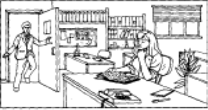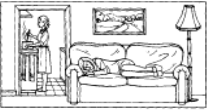Grammar tests are created to check student proficiency in matters ranging from inflections to syntax. Syntax involves the connection of words in a sentence, including matters such as word order, use of the negative, question forms, and connectives and etc. Each of the four components covers a different approach to testing grammar. The first what we are focusing on is limited response, that is especially useful for students at the beginning level. Other components involve multiple-choice completion, simple completion, and cloze tests are considered as the effective ones in testing grammar.
Grammar tests have an important place among vocabulary, grammar, and pronunciation exams in the target language. There are several reasons for this: Much ESL teaching has been based on grammar, and unlike various measures of communicative skills, there is general agreement on what to test. Grammar items, such as auxiliary verbs, are easy to identify, and errors in grammar can be quickly spotted and counted. As with vocabulary exams, either passive or active skills can be checked. Also, grammar can be connected to beginners or advanced learners. Even if one has doubts about testing grammar in a proficiency test, there is often good cause to include a grammar component in the achievement, placement and diagnostic tests of teaching institutions. [1. 141]
In testing grammar, we can do a good job of measuring progress in grammar class, and we can diagnose student needs in this area.
Limited response.
It can be checked the grammar of students with very little ability in the target language without having them speak or write anything. This can be done by means of directed physical responses and visuals. There are two basic ways in order to measure the grammar skills of these beginning –level students:
- Testing them one at time;
- Testing them in groups.
Individual testing
We can test students individually by using oral requests. These requests can ask for easily spoken replies or simply for nonverbal actions. When teaching students who know almost no English, we can even permit answers in their native language.
Examples: (students hear in English)
«How many tables are in the classroom?»
(students answer in their language)
When the numbers, colors and familiar classroom objects are learned, then we can test, for instance, different special questions confidently. We might ask, «Where are the three yellow notebooks?» or «Which two pens are red?» At the beginning student can answer simply by touching or pointing to the objects. Pictures can be used to test students individually or in groups. To check preposition recognition, we can ask, «Is the book on the table?» or we can say, «Point to the child behind the car. «And also pictures can also be used to test other matters such as verb tenses.

Fig. 1.

Fig. 2. [3, 24]
These pictures can be also used with challenging questions, for example,(checking past progressive, background situations, events) what was she doing when her mother made a meal?
Such kind of many pictures can be helped to evaluate learners’ knowledge about tenses in target language.
Group testing.
We can also test students in groups by using directed physical responses. In order to test preposition of places we can give «drawing» activity. First, explain and illustrate any new vocabulary words. Then, get student to make a drawing related to your spoken instructions: «Draw an airplane in the middle of the paper (Pause) Now draw a house below the airplane.(Pause). Next draw a cloud in front of the airplane». Using pictures like above we can test our students’ understanding of prepositions. For example, we can say, «Draw a circle around the person in the room» or «Draw an «X» on the girl sleeping on the sofa.» Sets of three or four related pictures can evaluate mastery of a number of grammar points. Here is a set that tests the comparative:
− (nonverbal) «Circle the picture that shows this sentence:» Boys are the same age.»
− (yes – no) «Look at picture «B.» Is this man as big as the boy?»
− (true – false) «Look at the picture «C.» Peter is taller than others.»

Fig. 3. A

Fig. 4. B

Fig. 5. C [4,103]
Normally we should use only one type of question on a test – all yes-no or all true-false activities.
Advantages of limited response:
1. It puts students at ease and avoids unnecessary stress.
2. It avoids skills such as reading and writing that have not yet been developed.
3. It can be scored easily and objectively.
Limitations of limitedresponse:
- Individual testing takes longer than group testing.
- It is difficult to find suitable pictures (although the teacher can make needed sketches).
- Only a limited number of grammatical structures can be tested. [2, 39]
MULTIPLE-CHOICE COMPLETION.
Multiple-choice test questions, also known as items, can be an effective and efficient way to assess learning outcomes. It includes an incomplete sentence stem followed by four multiple choice options for completing the sentence. Here is an easy sample item:
She ___ to school every day.
*A. goes B. go C. went D. gone
While multiple- choice completion is an efficient way to test grammar, teachers need to be cautioned about the temptation to use this kind of item for all of their testing needs. Many people are very excited about objective tests, feeling that multiple — choice objective exams in particular should be used to test everything. However, any given test is a kind of tool; It may be very useful for some jobs but not for others. For example, while multiple –choice test can be used successfully in testing grammar, they don’t seem to work as well in testing conversational ability.
Preparing multiple – choice completion grammar items follows about the same procedure for writing multiple choice completion vocabulary items:
- Choose the grammar points that you need to test;
- Prepare the right kind of sentence context (or stem) for the grammar structure;
- Select three logical distracters;
- Prepare clear, simple instructions. [2, 39]
Grammar choice.
Choosing grammar points to test is usually rather easy: determine what structures you have taught since the last test. The results on quizzes or homework assignments can show those things that students have learned well and those things that need reviewing. The points they know well can be largely ignored. A few of these, however, could be include at the beginning of the test to encourage students.
A related matter is how to give different «weight» to various grammar points. Let’s say you spent three times longer on model auxiliaries than on two word verbs. We could prepare two or three times as many questions on the models. This is part of the planning that is necessary. Before starting to write the questions, you need to decide how many of each grammar type to include.
All in all, we can say that the usage of different types of testing grammar techniques are helped to the language teachers to practice the all grammar items in teaching. Using more and more grammar exercises during lessons give great chances to the target language learners and they can easily make them into their practice.
References:
- Arthur Hughes. «Testing for language teachers». Cambridge University Press 1989.
- Harold S. Madsen. «Techniques in testing». Oxford University Press 1983.
- Mark Nettle and Diana Hopkins. «Developing Grammar in Context». Cambridge University Press.
- Virginia Evans. «Round up». Express Publisher. 2005.







